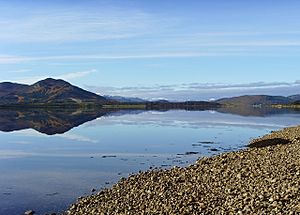Battle of Dornoch facts for kids
Quick facts for kids Battle of Dornoch |
|||||||
|---|---|---|---|---|---|---|---|
| Part of the Jacobite rising of 1745 | |||||||
 The Dornoch Firth from Meikle Ferry |
|||||||
|
|||||||
| Belligerents | |||||||
| Commanders and leaders | |||||||
| Casualties and losses | |||||||
| According to historian Ruairidh MacLeod Government officers including the Laird of Mackintosh surrendered with about forty men. According to historian Peter Simpson 300 of Loudoun's regiment were taken prisoner. The rebels captured four ships at the Ferry as well as 700 arms that were meant for Loudoun's Regiment. |
None | ||||||
The Battle of Dornoch happened on March 20, 1746, in Scotland. It was part of the Jacobite rising of 1745. This was a time when supporters of the Jacobites (who wanted to put Charles Edward Stuart back on the throne) fought against the British Government. Even though it's called a "battle," there wasn't much actual fighting. Instead, a large group of Jacobite rebels surprised the government troops. The government forces had to retreat quickly. The Jacobite attack was led by James Drummond, 3rd Duke of Perth in Dornoch, Sutherland.
Contents
Why the Battle Happened
The Jacobite Rising was a series of attempts to bring the House of Stuart back to the British throne. In 1745, Charles Edward Stuart, also known as Bonnie Prince Charlie, led a major uprising. He wanted to reclaim the throne for his family.
Government Plans in Dornoch
Lord Loudoun (John Campbell, 4th Earl of Loudoun) was a leader for the British Government. He was stationed in Dornoch. He thought the Jacobites would attack from the west, across the River Shin. He also believed the Royal Navy protected his eastern side. This was despite warnings that he might be wrong. On March 20, he left Dornoch early in the morning. He planned to ride to Invershin.
The Jacobite Attack
Around 8 AM, Jacobite Highlanders got ready to cross the Dornoch Firth. They were on the sands below Tain. One of their commanders, Donald MacDonald of Lochgarry, said his men worked hard to get the boats ready. The first group to cross had about 500 men from the Clan Fraser of Lovat and 300 from the Clan Gregor.
Landing and Marching
They landed at Meikle Ferry around 9 AM. They immediately marched towards Skibo Castle. Their goal was to capture Duncan Forbes, Lord Culloden and Norman MacLeod. Both were strong supporters of the government.
The alarm was raised in Dornoch. Lord Loudoun's soldiers, known as Loudon's Highlanders, prepared for battle. Major Mackenzie of Loudoun's Regiment gathered 120 men. They went to the ferry, arriving around 10 AM. There, they found 1500 rebels had already landed.
Government Retreat
The Jacobites' second group had also landed. The boats were going back for more men. The government's Mackay guards at the boats were only about 40 men. They retreated without firing a shot. Major Mackenzie's men also pulled back without fighting. The Jacobite Frasers then marched towards Dornoch.
A thick fog had helped the Jacobites. It allowed them to land without being seen easily. The Jacobites' third group landed around 11 AM. Lord Loudoun's regiment continued to retreat through Dornoch. Major Mackenzie sent the Laird of Mackintosh to ask about surrendering.
Government Forces Captured
Some government officers managed to escape. These included Captains Alexander Mackay and Sir Harry Munro, 7th Baronet. Others like Captain Lord Charles Gordon also got away.
Historian Ruairidh MacLeod says that the remaining officers, including the Laird of Mackintosh, surrendered with about 40 men. However, historian Peter Simpson states that 300 of Loudoun's regiment were taken prisoner. Most of the soldiers, about 900 in total, escaped to the Isle of Skye. The Jacobites captured four ships at the ferry. They also seized 700 weapons meant for Loudoun's Regiment.
Remaining Government Forces Retreat
Captain Alexander Mackay and about 160 men from Lord Loudoun's Regiment reached a spot near Lairg that evening. Lord Loudoun decided to leave his position. He split his troops. The Mackay and Sutherland men were sent north. Lord Loudoun and his own regiment went west.
The Jacobites did not push their attack right away. On March 21, they met west of Dornoch. On March 22, the rebels marched to find Lord Loudoun but found no one.
After the Retreat
On March 23, the rebels returned to Skibo and Dornoch. The Duke of Perth went back to Inverness. The Earl of Cromartie was left in charge at Dornoch. By March 23, Lord Loudoun had marched sixty miles to Loch Ewe. He reached Eddracharron in Strathcarron on March 24.
Lord Loudoun arrived in Sleat on March 26. He stayed there for a month. He had about 800 men with him. Other groups joined them, bringing their total to about 1300 men.
What Happened Next
On March 25, 1746, some government companies had a success at the Skirmish of Tongue. They captured money and supplies meant for the Jacobites from a French ship. They also took 156 Jacobites prisoner.
In response, the Jacobite leader, Charles Edward Stuart, sent a large force north. This force was led by George Mackenzie, 3rd Earl of Cromartie. However, they arrived too late. They were surprised and attacked by government troops. This was known as the Battle of Littleferry. The Jacobite force was completely defeated. They lost about 100 men. This defeat stopped them from helping the Jacobites at the important Battle of Culloden the next day.
See also

